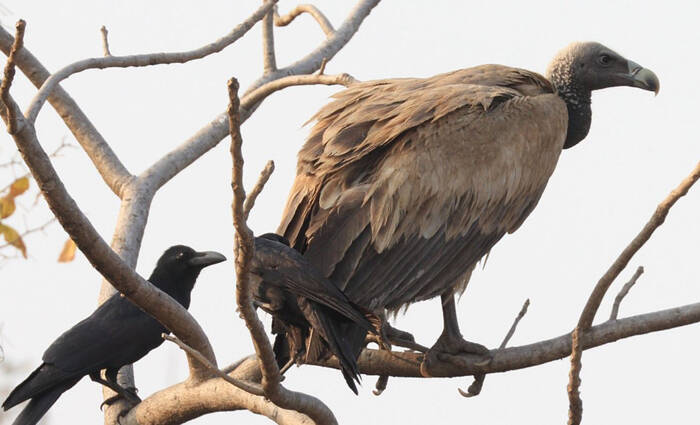Gyps indicus
IUCN
LCBasic Information
Scientific classification
- name:Gyps indicus
- Scientific Name:Gyps indicus,Long-billed vulture, Indian vulture, long-billed vulture, painted vulture,Indian Vulture, Indian Griffon, Long-billed Griffon, Long-billed Vulture, Painted Vulture
- Outline:Raptor
- Family:Falconiformes Accipitridae G.vultures
Vital signs
- length:80-100cm
- Weight:5.5-6.3kg
- lifetime:About 30-40 years
Feature
Nature's Cleaner
Distribution and Habitat
Resident: India and Pakistan; Wandering: Nepal; Origin uncertain (resident): Afghanistan.
The Long-billed Griffon vulture breeds in southeastern Pakistan and peninsular India south of the Gangetic plains, north to Delhi, east to Madhya Pradesh, south to the Nilgiris, and occasionally southwards (Collar et al. 2001). The species was first recorded in Nepal in 2011 (Subedi and De Candido 2013).
Inhabits towns and villages near cultivated land, as well as open wooded areas. Frequently seen near villages and parks. Nests mainly on plains and cliffs. Altitudes of inhabitation range from sea level to 2000 m above sea level.
Appearance
The sexes of the Long-billed Vulture are similar. The body length is 80-100 cm, the wingspan is 205-229 cm, and the weight is 5500-6300 grams. It is the smallest species in the genus Griffon. The whole body is covered with brown feathers, with pale feathers on the upper body and upper wing coverts. The flight feathers and tail are dark brown to black. The slender, hairless bald head is brown, with white down on the top of the head and nape, just like the neck. The neck is mainly black, with small white spots of white down. There is a white ruff at the base of the neck. The underparts are sandy brown with a wider light stripe. In flight, a distinct broad black trailing edge can be seen, and the thighs are covered with feathers, the same color as the rest of the underparts.
The beak is pale yellow. The iris is brown. The legs and feet are dark brown. Juveniles have darker plumage and a soft head and neck. Juveniles have a dark beak, pink head and neck, pale face, and brown and cream s
Details
The Indian Vulture is the smallest species in the genus Vulture and has no subspecies.

The Indian Vulture is a scavenger. Its main food is the carcasses of dead animals. It patrols over tropical savannas or human settlements in search of food. When it finds food, it moves out in groups. Most members are resident birds.
Long-billed vultures are scavengers of nature, usually feeding on the soft tissues of medium to large mammal carcasses. They also look for injured or weak sheep and cattle kept by humans. They are accustomed to sticking their heads into the abdominal cavity of animal carcasses and pecking at the internal organs and muscles. Vultures do not have strong feet and sharp claws. They rely on their keen sense of smell to find rotting animal carcasses and often fight over a piece of meat. They mainly feed on wild prey such as goats, deer and gazelles. As a scavenger, they mainly feed on carrion in urban and rural areas. They compete with false vultures for food in garbage dumps and slaughterhouses.
The breeding area of the long-billed vulture is relatively small, and the nest is usually built on cliffs and large trees. The nest is large, extending 60-100 cm. Made of sticks, green leaves and garbage. The breeding season is from mid-November to early March. Female vultures lay one oval white egg per nest, which is incubated by both parents for 50 days. Both sexes take care of the chicks, bringing food and protecting it. Only 50% of the nests can successfully raise chicks each year.
Since the late 1990s, the population of Central Asian vultures such as long-billed vultures and griffon vultures has dropped sharply by 97 to 99 percent in India and Pakistan. The main reason is a non-steroidal anti-inflammatory analgesic commonly used by veterinarians - diclofenac sodium. This drug, which can treat animal joint pain, is widely used to extend the working life of livestock. But the drug is used in large quantities in the last stage of the animal's life, resulting in a large amount of diclofenac sodium accumulating in their carcasses. When vultures feed on animal carcasses, they will inhale a large amount of this chemical and die from severe kidney failure.
In March 2005, the Indian government recommended that diclofenac be banned from use on animals, and that it be replaced with another non-steroidal anti-inflammatory analgesic, meloxicam, which is less harmful to vultures. As of March 2006, diclofenac was still widely used in India, and as of 2015, it is hoped that people's habits will change when meloxicam becomes cheaper than diclofenac.
Several species of long-billed vultures are included in captive breeding programs. However, due to the long lifespan and low reproductive rate of species such as long-billed vultures, it is believed that it will take at least several centuries to achieve success. The effectiveness of these programs depends on whether diclofenac is extinct in nature when the captive vultures are released into the wild. The government's commitment to controlling the use of the drug is crucial, but not until it is completely eliminated from the environment. A collaborative of bird conservation groups plans to keep all long-billed vultures in captivity within the next 20 to 30 years to avoid further deaths, which will further reduce the chances of successfully recovering this already rare species.
Listed in the IUCN Red List of Threatened Species 2017 ver3.1 - Critically Endangered (CR).
Listed in Appendix I, II and III of the 2019 edition of the Convention on International Trade in Endangered Species of Wild Fauna and Flora (CITES).
Listed in China's National Key Protected Wildlife List (February 5, 2021) Level II.
Protect wild animals and stop eating game.
Maintaining ecological balance is everyone's responsibility!








